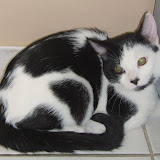Note: Major cuteness at end!
These last several weeks since my last update on the hoarder cats has been an emotional fruit cake. These weeks have included wild ups and downs, but overall I am doing okay. Just tired and trying to raise funds for the remaining surgeries/care for the Lancaster hoarder cats. This rescue has been extremely expensive (even with discounts and help) and we have a long way to go to pay for everything.
During this time we have learned quite a bit more about the eye problems in these cats and the pieces of the puzzle are beginning to come together. I had to know. I needed and need to understand.
Feline Herpes Virus-1
The entire Lancaster hoarder population (a total of 24 cats/kittens) is either an active feline herpes virus-1 (FHV1 or FHV-1) cat/kitten or a possible carrier. So, we must assume they are all carriers.
Feline herpes virus infection
Clinical signs
Feline herpes virus 1 (FHV-1) infection is a very common infection in cats. FHV-1 is an alpha herpes virus. It has been associated with many ocular diseases in cats including conjunctivitis, keratitis, corneal ulceration, symblepharon formation, chronic epiphora, eosinophilic keratitis, sequestrum formation, keratoconjunctivitis sicca and anterior uveitis. Primary infection with feline herpes virus manifests itself usually in the respiratory tract and the eyes. FHV-1 replicates in epithelium of nasal mucosa, conjunctiva, tonsil and nasal turbinates. Tissue damage during active infection is due to viral cytolisis.1 Clinical signs include lethargy, fever, sneezing, nasal and ocular discharge, conjunctival hyperemia and chemosis. One or both eyes may be affected. In more severe cases, the corneal epithelium is affected as well leading to corneal ulceration. Dendritic corneal ulcerations represent viral replication within the corneal epithelium. Corneal lesions are most common on days 3 and 12 of the primary infection. Lysis of conjunctival epithelium cells with subsequent virus release is responsible for the corneal lesions seen around day 12 of the primary infection.1 Dendritic ulcers may coalesce to form larger geographic ulcerations. Secondary bacterial infection may lead to deep corneal ulceration or corneal perforation. Iris prolaps and anterior synechiae may form after corneal perforation. Adhesions between third eyelid and the cornea or eyelids may lead to permanent protrusion of the third eyelid. The corneal epithelium may be replaced by conjunctival-like epithelium that contains blood vessels and is not completely transparent. Approximately 80% of cats infected with FHV-1 will become carriers of the virus after the initial infection. [edited by author to fit subject; bolding represents issues seen in these cats/kittens]
Source: Alexandra van der Woerdt, DVM, MS, DACVO, DECVO here.
NOTE: In these kittens,
symblepharon formation is represented by the adhesion of the third eyelid to the cornea. As you cat folks know, stress brings active herpes outbreaks. So every trip to the vet (we are sure hoping the last will be coming soon!) stalls containment.
Many of t
hese cats--in fact a remarkably high number--also have microphthalmia (tiny eye) (and here, page through for several discussions, but warning the photos on this site which is about feline ophthalmology may be too rough to view for some of you) and even micro microphthalmia. This is a congenital condition where the eyeball, at some points, ceases to further develop. NONE of the adults in our possession have this disorder.
ALL of the kittens, and all but two of the adults, also suffered from secondary eye infections.
So while some of this is congenital, complete lack of care (aka neglect) took the several compounding factors and made them much worse. Iris prolapse, for instance, doesn't just 'happen'. It is the result of a herpes sick eye, left untreated, which ruptures.
Mazzie, who I discussed in my last post, will be getting her spay staples out tomorrow and the very last of her vaccines. She is now blind, but doing pretty well. Here is a photo of her taken approximately 7 days after her surgery:

Mazzie's left eye is microphthalmic with secondary infection. This eye is still being treated. The eye removed included infection, herpes corneal ulceration and iris prolapse.
Mercury also had his eye removed, but his sighted eye is getting much better. The eye removed, like Mazzi, included infection, herpes, corneal ulceration and iris prolapse. Merc is a spirited little boy and will do just fine as a monocular kitty. He plays just like the others and with the exception of the missing eye, one can tell little if any difference between him and his normal-sighted siblings.

Jupiter has glaucoma as a result of a ruptured herpes eye. Nothing genetic here. Her normal eye is doing well. Jupiter's most recent (11/11) exam indicated that her eye is less sore and perhaps a tiny bit less enlarged and less infected. Though this condition is NOT reversible, and the eye will require removal, this is at least temporary good news for Jup while we raise the money for her ultrasound to address her loud and rather severe IV/VI heart murmur which must be done prior to surgery. Photo taken 10/22.

Mars, Comet, Black Hole and Swiss were scheduled for single enucleation (eye removal), but in the end, the opthalmologist advised leaving the eyes in place. Each has a microphthalmic eye, and each is blind in this eye. We have treated for infection and for herpes, and continue to treat. Each is now fully vetted except for their microchip. I am working on getting some good pictures of each of these kittens at play. The veterinary photos no longer reflect their reality.
Venus has a number of problems. She is right eye entropian, bilateral symblepharon (see above):
Entropion is the inward rolling of all or part of an eyelid. The cornea and conjunctiva are irritated by hairs on the eyelid causing problems from mild discomfort and tearing to chronic pain and eye injury. Entropion is more common in dogs than cats, but may be under-recognized in cats. In this study from the U.K., 50 cats with entropion were examined. About 1/3 of the cats had a mean age of 4 years, while the remainder of the cats were relatively older, with a mean age of 11 years. Among the younger cats, entropion was likely to be caused by a pre-existing irritative disorder, such as conjunctivitis or corneal ulceration. [my bolding]
Source: Wynn Foundation,
here.
Here is Venus on 10/22 at the vet. The difference between her entry photos and this photo is drastic, but still, it appears she will have to have both eyes removed. The jury is still out though. She is being spayed this week, and has all other vetting complete except for microchipping. We continue to treat her eyes 3x/daily.

Galaxy is a success story. While we might not be able to save her right eye (jury still out, she is symblepharon R eye, we HAVE saved her left eye so she will remain sighted. This is a huge relief given we could not even tell if she HAD eyes when she arrived. She is being spayed this week, and all other vetting except for microchipping is complete. We continue to treat her eyes 3x/daily.
Photo at vet 11/11/09

Moo, Brie, Mixed Nuts, Jack and Garganzola while still undergoing medication, all have saved eyes and will be normal visioned for the most part. There is corneal scaring on some, and Jack has corneal plaque. But they are otherwise healthy and happy cats. Moo and Mixed nuts are now fully vetted except for microchipping, and Brie, Jack and Garganzola will be spayed/neutered, respectively, this and next week. If they react to this stress as the then-healthy-eyed Mixed Nuts and Moo did, we can expect the stress to bring on active herpes--again, which we will treat until they are again stable.
Sigh.
Now for the Blessings!Some very good friends, and some new ones, are helping us raise money and get help. I cannot--absolutely cannot--do this alone. The time alone in caring for these cats/kittens is huge.
Consider:
We go through 1400 lbs. of litter/month
1.5 cases (and rising as they get older) of food/day
Medication includes treating 60 eyes/day plus other care
Cleaning and laundry, well... we never stop!
So this help in raising funds and getting necessary supplies is greatly appreciated. The help and support of other rescue friends has been critical to keeping me sane. This is extremely hard work and, as you can imagine, extremely time consuming. We have also received help from Best Friends (Utah) and United Animal Nations. Actors and Others have helped with a small discount off spay/neuter fees. Saddleback Valley Humane will be paying for Jupiter's spay. Ruff donated $50.00 to the general veterinary bill. Every penny helps and is deeply appreciated.
And here are two more blessings.
Meet Captain Whitebeard and Captain Greyblaze who are now 7wo and healthy as little horses! They were born here the day after their very preggers mom, Little Star, arrived:
Captain Whitebeard


Captain Greyblaze
While resistant to weaning (mmmpff!), these two balls of cuteness are doing just great. Mom will be vetted when they leave to go to kitten rescue to find their furrever homes in about a week. We have been careful in the extreme with these little ones and they will soon be in the arms of fosters who will do likewise in a disease-free environment as their mom's immunity begins to wane and they become more vulnerable. We are grateful for the help of other rescues who have agreed to take a few kittens for us as they are releasable.
AND Mazzie has a home. Another excellent rescuer with herpes cats will be taking the very precious little Mazzie! Horray for Mazzie!
Another blessing is knowing that while many kittens died (her admittance) a rather terrible death at the hands of this hoarder, these kittens didn't. And thankfully we got to many of them in time to save their sight. They will have a future now.
So amid the darkness and the oft disappointment, I have to remind myself that I was given the privilege of caring for these cats and kittens.
I really and truly believe that God gifts each one of us in some way. I know my true gift and have been using it for several decades. I'm really glad that God gave me the gift he/she did.
And for Baby Bell who did not make it, Godspeed little one. She has been cremated and her ashes spread in a wildlife sanctuary.












































